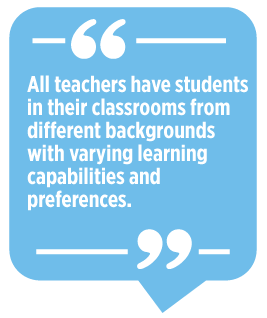
Today’s mixed-ability classroom is rich and colorful in terms of learners’ diverse backgrounds and needs. According to Tomlinson (1999), differentiated instruction (DI) is a process through which teachers improve learning via matching students’ characteristics to instruction and assessment. Content, process, product, and learning environment are the areas through which differentiation can be incorporated.
Differentiated Instruction
Why It Is Necessary
Afrab (2015) indicates that some teachers prefer rote learning while others prefer in-depth comprehension. Similarly, some teachers favour lecture-based teaching while others choose demonstration and hands-on activities. Students also have wildly varying preferences: Some students want to learn alone, others with peers; some prefer fast-moving learning, others want demonstration and reflection (Afrab, 2015, p. 95).
Successfully managing these diverse classrooms means that DI strategies become very important. In this day and age, DI implementation is all but compulsory, because all teachers have students in their classrooms from different backgrounds with varying learning capabilities and preferences. Their students differ from one another in learning potential, interests, and intellect (Afrab, 2015).
How It Benefits Students
A number of studies have reported findings on the benefits of DI in language classrooms, such as
- addressing a variety of learning styles,
- facilitating individual growth in large classes,
- increasing student engagement and motivation,
- boosting overall course satisfaction, and
- even improving academic success (Dixon, Yssel, McConnel, & Hardin, 2014; Karadag & Yasar, 2010; Dosch & Zidon, 2014; Turner, Solis, & Kincade, 2017).
However, teaching in differentiated classrooms is not necessarily easy (Tomlinson, 1999)—it requires teachers to design lesson materials focused on different personality characteristics, learning needs and styles, intelligences, readiness levels, and student interests.

Challenges
Teaching such diverse student groups requires creating a diversified lesson plan with numerous tasks and activities fulfilling the needs of all learners. Addressing all these needs highlights classroom instruction focused on and modified by students’ interests, needs, and readiness by providing a comfort zone for learning; this is important because using the same method of teaching for all students leads to a decline in students’ learning abilities (Tomlinson, 1999).
Studies show that even though DI is a good strategy to implement in English classes, addressing different levels of student readiness, process skills, and product determination can be challenging for teachers (Dixon et al., 2014).
Differentiated Instruction in Practice: The Uzbek Context
Considering the mixed ability of learners, there is a big need to implement DI strategies in school classes in Uzbekistan. Few studies have systematically evaluated the use of DI strategy in EFL classes in Uzbekistan schools, and it was very important for us, as researchers, to understand for the Uzbek context:
- How do teachers actually differentiate instruction?
- What barriers do teachers believe prevent implementation?
Our study was intended to better understand English teachers’ beliefs and perceptions toward DI in EFL classes, and we focused on the following research questions:
- Do teachers use DI in their classes?
- How and why do they differentiate instruction, or why not, if they do not?
- What are teachers’ perceptions about DI?
The study was mixed, consisting of lesson observations, semistructured interviews, and questionnaires.
Participants
Participants included 10 teachers per school in 10 schools (100 teachers), consisting of 14 male and 86 female participants. Participants were asked to complete the 38-item survey about DI elements to find out whether they use them in teaching. Participant information follows:
- Average age: 33.7 years, ranging between 22 and 61 years
- Teaching experience: Ranging from 5 months to 40 years
- Teaching level: 16 teachers had English lessons with primary classes, 22 teachers with secondary classes, 10 with high school classes, and 52 with all
Statistical data analysis showed that being familiar with DI strategies is closely related with experience, teaching grade, and age.
Lesson Observations
We were very interested whether language teachers use DI elements in their classes—and why. We observed 10 English teachers twice; each observation lasted 45 minutes. During the observations, we noted that the following DI elements were used:
Used Frequently
- providing materials to students in their L1
- encouraging learners to work together or individually
- providing a list of keywords
Used Infrequently (Once or Twice)
- use texts with highlighted key parts
- use video materials to supplement and support explanations and lectures
- provide materials for encouraging further study of topics of students’ interest
- give students time to think and reflect before answering
- provide homework based on students’ readiness
- use interest-based working groups and discussion groups
- balance competitive, collegial, and independent work arrangements

Interview
The interviews lasted an average of 15 minutes and contained 21 questions, starting with questions about years of work experience and which educational institution they graduated from to create a warm atmosphere. We then moved on to questions about participants’ familiarity of DI elements, understanding of DI strategies concerning the elements of content (what is to be learned) and process (how students acquire information). Moreover, some questions were devoted to whether they had experienced DI in their classes.
The most interesting finding from the interview process was that some teachers had misconceptions about the definition of learning style; in fact, they confused learning style with language skills, believing that learning style is when students learn from reading, writing, listening, and speaking.
A question about using the first language (L1; Uzbek or Russian) in class gave us the results shown in Table 1.
Table 1. Using the First Language in the Classroom
|
Do you ever use L1[Uzbek/Russian] in the class? | |
|
Answers |
Number of teachers |
|
Yes |
14 |
|
Sometimes |
3 |
|
Rarely, try to give definition |
1 |
|
Sometimes I use, sometimes I don’t. It depends on the situation |
1 |
|
Often |
1 |
For the question, “For what purposes do you use L1?”, five teachers answered that they use L1 to translate words, and more than 20 teachers answered that they used it for explanations so that learners could better understand a topic discussed. It was observed that most teachers used the L1 during their lessons for about 20–29 minutes.
Conclusion
According to the results of the research conducted by Turner et al. (2017) and Dixon et al. (2014), the main reason that teachers face challenges in implementing DI is poor preparation for properly using DI.
Our research results investigating DI in EFL classes in Uzbekistan show that
- teachers are not aware of DI;
- teachers are textbook oriented;
- teachers assume that they are conducting lessons using a communicative approach, but this approach is absent;
- teachers are still using the grammar-translation method;
- teachers use the L1 a lot and, as a result, learners do not have access to English;
- teachers provide little opportunity for students to interact; and
- grammar and vocabulary are taught at the word level or sentence level rather than in context.
We can observe that
- teachers seldom experienced DI in their teacher preparation programs;
- teachers had few, if any, opportunities to see multitasking classrooms in their training; and
- teachers need more practice in differentiation through workshops that allow them to understand DI concepts and have a clear picture.
By understanding the needs of students, teachers are able to modify their teaching practices and use different instructional methods to deal with diversity, allowing all students to reach the same target, even if they take different routes.
Acknowledgement
The research concerning English teachers’ beliefs and opinions about DI in language classes was developed and conducted under the project “Scholarly Research and Publication for ELT in Uzbekistan,” organized by the U.S. Embassy in Tashkent and Uzbekistan Scientific Practical Innovation Center. We are very grateful to Dr. Gena R. Bennett, English language specialist, for all her help and support in doing research. We gratefully thank Mr. Timothy Collins, RELO in Central Asia, and Mr. Joseph Bookbinder for financial support in presenting at the 2019 TESOL International Convention & Language Expo.
References
Afrab, J. (2015, December). Teachers’ beliefs about differentiated instructions in mixed ability classroom: A case of time limitation. Journal of Education and Educational Development, 2(2), 94–114
Dixon, F. A., Yssel, N., McConnel, J. M., & Hardin, T. (2014). Differentiated instruction, professional development, and teacher efficacy. Journal for the Education of the Gifted, 37(2), 111–127.
Dosch, M., & Zidon, M. (2014). “The course fit us”: Differentiated instruction in the college classroom. International Journal of Teaching and Learning in Higher Education, 26(3), 343–357.
Karadag, R., & Yasar, S. (2010). Effects of differentiated instruction on students’ attitudes towards Turkish courses: An action research. Procedia Social and Behavioral Sciences, 9, 1394–1399.
Tomlinson, C. (1999). The differentiated classroom: Responding to the needs of all learners. Alexandria, VA: Association for Supervision and Curriculum Development.
Turner, W. D., Solis, O. J., & Kincade, D. H. (2017). Differentiating instruction for large classes in higher education. International Journal of Teaching and Learning in Higher Education, 29(3), 490–500.
|
Download this article (PDF) |
Nilufar Jamoliddinova is senior English language teacher and teacher-trainer at Namangan State University, Uzbekistan. Nilufar presented at the 2019 TESOL International Convention & Language Expo, Atlanta, Georgia.
Yana Kuchkarova is a teacher-trainer at Namangan State University and English language instructor in the ACCESS STEM microscholarship program. Yana presented at the 2019 TESOL International Convention & Language Expo, Atlanta, Georgia.
| Next Article |
